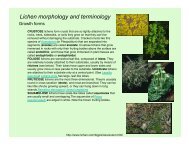Arctic Ecosystems in Russia - Alaska Geobotany Center
Arctic Ecosystems in Russia - Alaska Geobotany Center
Arctic Ecosystems in Russia - Alaska Geobotany Center
You also want an ePaper? Increase the reach of your titles
YUMPU automatically turns print PDFs into web optimized ePapers that Google loves.
ARCTIC ECOSYSTEMS IN RUSSIA 427<br />
species diversity, and productivity <strong>in</strong>crease <strong>in</strong> early<br />
succession, reach their maximum at <strong>in</strong>termediate<br />
stages, and then decrease aga<strong>in</strong>. The structure of<br />
vegetation cover and animal communities <strong>in</strong> the<br />
typical tundra subzone are most complicated <strong>in</strong><br />
frost-boil tundra, with its patches of bare ground<br />
at different stages of overgrowth, and not <strong>in</strong><br />
communities with a cont<strong>in</strong>uous cover. There are<br />
no data on the speed of succession, but this process<br />
probably extends for hundreds and even thousands<br />
of years.<br />
Overgrowth of sands<br />
Large sand masses are not very frequent <strong>in</strong> the<br />
Eurasian tundra zone. They are associated with<br />
seas and rivers. The most extensive sand outcrops<br />
are found <strong>in</strong> relatively small islands (Belyi, Sibiryakova,<br />
Olenyi, and others), as well as on the<br />
pen<strong>in</strong>sulas Yamal and Gydan. Information about<br />
the <strong>in</strong>itial stages of sand overgrowth is scarce<br />
(Matveyeva, 1980; Matveyeva and Zanokha,<br />
1986). Solitary vascular plants typically occur on<br />
unconsolidated sands subject to w<strong>in</strong>d action; the<br />
majority of these plants cannot be called psammophils<br />
<strong>in</strong> the narrow sense s<strong>in</strong>ce they also grow on<br />
loams <strong>in</strong> "zonal" communities.<br />
The nonspecificity of the pioneer flora on the<br />
sands is typical of high latitudes. In different<br />
regions of the Eurasian <strong>Arctic</strong>, there can be various<br />
species of forbs (Armeria maritima, Artemisia<br />
borealis, Cerastium arvense, C. regelii, Lloydia<br />
serot<strong>in</strong>a, Myosotis asiatica, Oxyria digyna, Papaver<br />
pulv<strong>in</strong>atum, Parrya nudicaulis, Potentilla<br />
hyparcticd), grasses (Deschampsia glauca, Festuca<br />
cryophila, Koeleria asiatica, Poa alpigena, P. arctied],<br />
and woodrushes (Luzula confusa, L. nivalis).<br />
Most typical is the horsetail (Equisetum arvense<br />
ssp. boreale). None of these form a closed cover,<br />
and their role <strong>in</strong> fix<strong>in</strong>g sands is not great. The ma<strong>in</strong><br />
role <strong>in</strong> stabiliz<strong>in</strong>g the loose, dispersible substrate is<br />
performed by dwarf-shrubs such as Salix nummularia<br />
and Dryas punctata, which form a compact<br />
appressed mat. Consolidation of the surface can<br />
also be brought about by liverworts such as Gymnomitrion<br />
corallioides and crustaceous lichens with<br />
black thalli which fasten the sand gra<strong>in</strong>s together,<br />
form<strong>in</strong>g a th<strong>in</strong> fragile crust. This crust is easily<br />
destroyed under the action of w<strong>in</strong>ds, snow erosion,<br />
and cryogenic processes. Succession is also opposed<br />
by the active process of sand deposition.<br />
Therefore, the <strong>in</strong>itial stages can last for an <strong>in</strong>defi-<br />
Fig. 16.62. Polygonal mire <strong>in</strong> the typical tundra subzone at<br />
Tareya, Taymyr.<br />
nitely long time. The gradual growth of the cryptogamic<br />
crust and the <strong>in</strong>crease <strong>in</strong> the size of dwarfshrub<br />
cushions result <strong>in</strong> the consolidation of the<br />
sandy soil. All successions on sands appear to pass<br />
through the Dryas stage, after which a moss cover<br />
of Hylocomium alaskanum is gradually formed. In<br />
the end, a closed cover of mosses, dwarf-shrubs,<br />
and lichens can be formed; however, if crack<strong>in</strong>g of<br />
the ground <strong>in</strong>to polygons takes place, then the<br />
vegetation becomes differentiated <strong>in</strong> the same way<br />
as <strong>in</strong> frost boils and polygonal stands on the<br />
"plakor". As the plant cover is form<strong>in</strong>g, soil is also<br />
develop<strong>in</strong>g under it. At late stages of succession of<br />
dispersible sands, the vegetation is similar to that<br />
of the "zonal" communities on the "plakor", although<br />
some dist<strong>in</strong>ct features of the floristic composition<br />
rema<strong>in</strong> for a long time.<br />
Dynamics of vegetation <strong>in</strong> the formation of mires<br />
Many varieties of mires occur <strong>in</strong> the tundra zone<br />
(Boch and Mas<strong>in</strong>g, 1983). Most typical <strong>in</strong> the<br />
arctic landscape are the polygonal mires (V.N.<br />
Andreyev, 1938, 1955; Petrovskyi, 1959; Aleksandrova,<br />
1963; Boch, 1974, 1980; Tyrtikov, 1974).<br />
They form a network of large polygons (Fig.<br />
16.62) from 7 x 10 to 20 x 30 m <strong>in</strong> size, separated<br />
by troughs. This pattern results from the formation<br />
of polygonal ice wedges. Under the action of<br />
cryogenic processes, ice-crack nets are formed <strong>in</strong><br />
some areas of river floodlands, lake banks, and<br />
seaside marshes. In the course of time, the ice<br />
wedges become wider and the edges of the polygons<br />
rise slightly. The central concave parts of the<br />
polygons are saturated or filled with water, while




